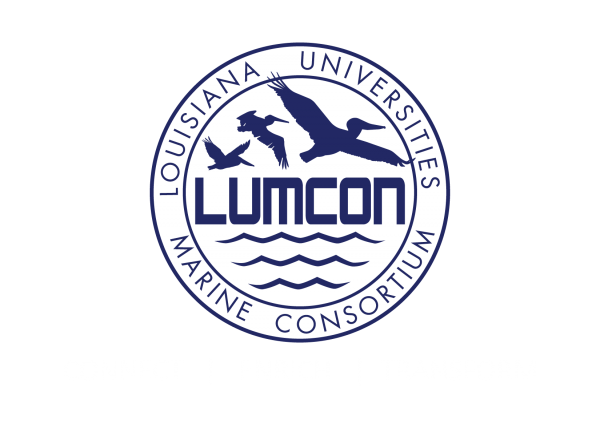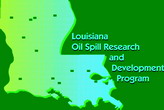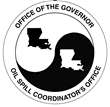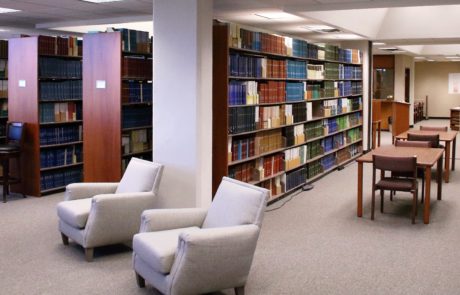LIBRARY
MAIN CATALOG (Electronic Resources/LUMCON Library)
Click here to search the Dispersants Bibliography
Click here to search Effects of Offshore Oil and Gas Development Bibliography
ABOUT THE LIBRARY
The LUMCON Library collection was originally housed in Ellender Memorial Library, located at Nicholls State University in Thibodaux, Louisiana. After completion of the DeFelice Marine Center in 1986, the collection was moved to its present location. Since that time, the Library has become an active resource center for LUMCON faculty and staff as well as Consortium member institutions, visiting researchers, students, and the public.
The library contains a computer lab and several study spaces available to visiting students, scientists, or groups (such as attendees of a writing retreat).
The collection and development of library materials reflects LUMCON’s research programs. The collection has approximately:
- 4,600 monographs
- 5,800 bound volumes
- 200 journal titles
- 26 current journal subscriptions
- 850 maps
- 35 atlases
- 3,600 government documents
- 1,500 reprints
In addition, the library houses a complete collection of research products generated by DeFelice Marine Center personnel since LUMCON’s inception.
HOURS OF OPERATION
- The LUMCON Library is staffed Monday through Friday from 7:00 AM to 3:30 PM. All visitors are welcome during these hours.
- The Library is closed to the public on weekends, state holidays, and when the librarian is not on site. Before visiting the facility, please call 985-851-2875 to ensure the Library will be open.
- All LUMCON staff, summer students, and resident visitors have 24-hour access to the Library. If the doors to the Library are locked, the security guard will open them for you.
CIRCULATION
- Books can be checked out by filling out a card at the circulation desk. The length of time a book can be checked out varies depending on the patron’s status. Books may be renewed by contacting the department, but all items are subject to recall at any time.
- Interlibrary loan service is available for LUMCON faculty, postdocs, lab personnel, and summer students. Although we strive to get items at no charge, the patron may be asked to pay for interlibrary loan charges under certain circumstances.
- Reserve items, reference materials, and journals must remain in the Library. The Library has no photocopier, but copies or scans can be made in the LUMCON main office.
- All materials must be checked out before removal from the Library, without exception.
- Library materials can be placed on reserve for summer classes. A list of items to be placed on reserve should be provided to the librarian as soon as possible.
- When returning material that has been checked out, please drop off items at the circulation counter.
Food is not allowed in the Library under any circumstance. Drinks are only allowed with prior approval by the librarian or the security guard.
INTERNSHIP PROGRAM
The LUMCON Library is available as an internship site for graduate-level students who have completed at least two semesters toward a Master’s degree in Library and Information Science. Applications will be accepted on a continuing basis and internships may be completed during any semester. Prior library experience or an undergraduate degree in science is desirable, but not necessary. Credits will be awarded based on the number of person-hours completed (40 person-hours per credit hour).
The internship will consist of both field experience, encompassing many operations of a special library, and a special project in technical services. The Librarian will give the intern an overview of reference services, technical services, library administration, and budgeting, and will guide the intern through special projects. The LUMCON Library uses SIRSI/Dynix’s Symphony Integrated Library System as well as OCLC for Cataloging/Interlibrary Loan services.
Contact the Librarian for more information or to apply for an internship.
ACKNOWLEDGMENTS
We would like to thank the following individuals for their guidance and input when creating the Dispersants Bibliography:
-
- Victoria Broje, Per Daling, Alun Lewis, and Francois-Xavier Merlin offered valuable assistance in the early phases of this project. Per Daling’s support was especially noteworthy, by providing conference proceedings that otherwise could not be obtained.
- Deborah Ansell, ITOPF’s librarian, contributed by sharing her sizeable list of library holdings on dispersant publications with us, and filling in gaps where existing citation information was incomplete.
- Likewise, Julie Anne Richardson, librarian for Environment Canada, compiled a publication listing on dispersants housed in her collection, which provided us with additional citations for our project.
- Qianxin Lin at Louisiana State University provided API conference proceedings for us to use in transcribing abstracts.
- Nancy Kinner at the Coastal Response Research Center provided encouragement, focus, and connected us with some of the aforementioned people.
- Finally, Don Davis and Karen Reeder Emory at OSRADP deserve special mention for all of their help and direction during the span of this project.
 |
 |
 |
The LUMCON Library is a member of the International Association of Aquatic and Marine Science Libraries and Information Centers (IAMSLIC), the Southeast Affiliate of IAMSLIC Libraries (SAIL), and the Louisiana Library Network and Information Consortium (LOUIS). Additionally, the Library has access to OCLC Cataloging/Interlibrary loan services.
Click here to search LUMCON’s e-Library catalog using the LOUIS portal.
DISPERSANTS BIBLIOGRAPHY
Primary production of arctic marine phytoplankton was studied in situ to determine the effects of crude oil, Corexit, and oil/Corexit mixtures. Rates of production varied by type and concentration of doses, method of pollutant/seawater mixtures, environmental conditions, and species composition. Primary production inhibition correlated with oil concentration. Oil/Corexit mixtures were more toxic to species than doses of either oil or Corexit
This laboratory study was to describe properties of four chemically dispersed oils within natural beach sands. The influence of temperature on the adsorption characteristics of dispersed oil to marine sediment was almost negligible, within 10 to 30°C. With certain amount of oil and varied dispersant/oil ratio, oil in top sediments following flushing was not affected by the increase in dispersant application. The application dosage of dispersant had no more influence on releasing oil to deeper sediment or water than the amount of oil applied. When the outflow rate of flushing water doubled, the amounts of oil retained in surface sediment following flushing increased for about 6%. It was observed that the tested soap water acted effectively in dispersing floating oil, which was similar to that of the chemical dispersant used in this study
A comparison of the movement of dispersed oil in marine sediment under two dispersant application scenarios, applied prior to and after oil being spilled overboard, was examined. The pre-spill application scenario caused much less oil to be retained in the top sediment than post-spill scenario. The difference in oil retention in the top sediment between pre- and post-spill application scenario increased with increase in fuel oil temperature. For fuel oil above 40 °C, the difference in the effect of pre-spill application strategy under various water temperatures was negligible. When soap water was used as replacement for chemical dispersant, almost one-half as much oil was retained in the top sediment as that when using chemical dispersant. The adsorption of dispersed oil to the top sediment was almost proportionally decreased with doubling of soap dosage
Canada, with its immense arctic and subarctic regions, wants to develop the promising hydro-carbon potential of the Beaufort Sea, the high arctic islands, the eastern arctic and Labrador. Of necessity, Canada has gradually become a world leader in arctic marine oil spill research. Some of this research has been done by the Canadian federal government through AMOP, the Arctic Marine Oilspill Project. There has been joint oil industry/government research, such as the Beaufort Sea Project and the Baffin Island Oil Spill Project. In oil company initiatives, Dome Petroleum has been a leader in the Beaufort Sea region. Finally, a cooperative oil industry organization, the Arctic Petroleum Operators' Association and its research group, the Canadian Offshore Oil Spill Research Association, have made many important studies. Initial efforts aimed to strengthen existing containment and recovery equipment to operate in light ice conditions. When the limits of this technology were rapidly reached, research turned to developing burning techniques, including fireproof booms, in situ burning against ice edges and in spring melt pools, air deployable igniters and portable burners and incinerators. New dispersant technology was developed for aerial application, for cold water dispersion and for solidification. The effects of dispersed oil in the arctic nearshore and onshore environment were assessed. More recently, subsea containment has become an important area of study. Future research will include methods of mechanical recovery of oil in ice, oil/water emulsions in and under ice, and the mechanism of oil migration upward through pack ice
Subtidal benthic biota were monitored for petroleum hydrocarbons following two experimental oil spills at Cape Hatt, N.W.T., Canada. In one spill oil was chemically dispersed into the water column, and in the other oil was released onto the water surface and allowed to strand on the shoreline. In addition to baseline samples, samples were collected immediately after the oil releases, two to three weeks after and one and two years after. Initial observations did not distinguish between the effects of the surface and dispersed releases. Total oil content and hydrocarbon compositional analyses were conducted to investigate patterns of uptake and depuration for five different arctic species: Astarte borealis, Macoma calcarea, Mya truncata, Serripes groenlandicus and Strongylocentrotus droebachiensis. Filter-feeding species took up oil rapidly from the water column, while deposit-feeding species took oil less rapidly from the sediments. All species depurated most of the oil after one year, but after two years the deposit feeders appeared to be taking up more oil from sediments contaminated by stranded oil from the surface oil release
There are many sources of oil pollution in the Red Sea and, therefore, a considerable potential for damage to coastal systems where spilled oil tends to accumulate. Seagrasses are very common in the shallow, sheltered areas along the shorelines, and the seagrass beds can thus be classified as highly vulnerable, Depending on the degree of oiling, short-term effects on the seagrass plants can be expected, particularly when the above-ground plant parts (the leaves and leaf sheaths) are in direct contact with floating oil. However, there is no evidence of significant long-term or persistent effects, unless the beds are completely covered with oil or below-ground plant parts are affected by oil penetration into the sediment. As a consequence of the sensitivity of specific algal and faunistic components of the seagrass system to acute and long-term exposures to oil, adverse population changes may persist for long periods of time. The ultimate effects on the seagrass system to acute and long-term exposure to oil, adverse population changes may persist for long periods of time. The ultimate effects on the seagrass system largely depend on its complexity and the vulnerability of the habitat. The complexity of the system is determined by the number of vertically arranged vegetation layers, each characterized by its own specific floral and faunal assemblages. The number and characteristics of these layers are generally related to the seagrass growth form, rather than to the seagrass species. In the intertidal zone the complexity of the system increases with percentage water coverage and in the sublittoral with increasing depth; a maximum usually occurs a few metres below extreme low water level. Thus, the most complex and susceptible part of the system tends to be situated at depths where the likelihood of serious long-term exposure to spilled oil and subsequent damage is small. Seagrass in the intertidal area forms a definite buffer between floating oiland the community components under the leaf canopy. Acute exposure incidents will lead to a simplification of the community structure. Chronic exposure will lead to a gradual modification of the structure and basic processes. However, as long as the frame of the community, i.e. the seagrass itself, is not seriously affected, the system is able to regain stability more easily than other, unvegetated parts of the coast. Recovery times are estimated to be one to a few years. Where the seagrass itself is damaged recovery may last several decades. Proper selection of spill-combat methods may effectively prevent oil from reaching the vulnerable shorelines. Usage of dispersants offshore and mechanical clean-up on- and near-shore are discussed in view of their potential for additional damage to the seagrass system
An experimental study was conducted to determine the drop size distributions in a dispersant-treated oil-water system. Two different chemical dispersants, Surflow-OW-1 and Corexit 9527, were used. The effect of the method of application of dispersants on drop size formation and its distribution was also studied as a function of the input energy and shear rate. The oil-water interfacial area was computed by use of the Sauter mean drop diameter and the dispersed phase holdup. The peak values of the drop size distribution curve have shown a tendency to decrease with increasing energy input. It was also found that the self-mixing dispersant had yielded lower peak values than Surflow-OW-1, indicating finer and better dispersion. The interfacial area was found to increase as the input energy increased
Tests were undertaken to determine the effects of oils and dispersants on marine gastropods (Nodilittorina exigua, Littorina brevicula, Purpura clavigera). Direct exposure to concentrated dispersants were lethal to the gastropods, and diluted dispersants caused severe damage to the orgamisms. At concentrations below 250 ppm, P. clavigera was mobile enough to move out of contaminated areas
In the development of dispersal techniques using tugs and other sea-going vessels for oil spill cleanup operations, the dispersant were supplied in steel drums of 40/50 gallon capacity. This report describes the considerable difficulties experienced with the loading, unloading and usage of these containers. Tank storage below deck and pillow tanks are now recognised as considerable improvements, and the advantages and disadvantages of the various possibilities are discussed
This report gives a specification for the supply of dispersants for use in combating oil pollution it replaces Report No. LR 162, put out by Warren spring Laboratory in Nov 1972. This repot has also been produced with the advice and agreement of the Dispersant Working Party of the Institute of Petroleum. Additions have been made to cover the newer generation of dispersants that are not hydrocarbon-solvent based. As well as the specification, the report gives general background information and recent ideas concerning the formation, composition and usage of materials intended to disperse oil, and a list of all those dispersant materials that have been received at warren spring laboratory, have been examined according to the procedures in use at the time of receipt and have received approval by the Laboratory up to 1 Jan 1974. It is noted that this specification has been produced primarily for use in the United Kingdom and performance rating may be changed by different conditions of climate and salinity
The acute effect of oil pollution on birds is on their thermal balance. Oil adheres to the plumage and causes a reduction in the water repellent properties of the plumage, causing water to penetrate into the plumage to displace the insulating layer of air. The effect of oil on the plumage insulation is dose-dependent. The effect of oiling is greatly enhanced when the oil is spread in the plumage due to preening. In water, plumage oiling may cause the heat loss to exceed the bird's heat production capacity, resulting in hypothermia. If the oiled bird is ashore, with a dry plumage, it may have a normal thermal insulation. Bird species dependent upon feeding in water (such as diving birds) are therefore much more susceptible to the harmful effects of oil pollution than are semi-aquatic species that can feed ashore. It is possible to restore the water-repelling and insulative properties of the plumage by the process of cleaning if all the oil and soap is removed and if the plumage is completely dry. Chemical treatment of oil has been suggested as a way to reduce the impact of oil spills on avian life. However, very few reports seem to have addressed the effects of chemically treated oil on the thermal balance of birds, and the results from one study actually indicate that oil treated with dispersants may be more harmful to birds than oil. The urgent need for more information about the effects of chemically treated oil on aquatic birds is therefore stressed
Thermoregulatory effects of ingested doses of Statfjord A crude oil and of this oil mixed with the dispersant Finasol OSR-5 were studied in adult domestic ducks (Anas platyrhynchos) exposed to ambient temperatures of +16°C and -17°C. The data show that ingestion of both the crude and the oil-dispersant mixture resulted in an increased body temperature (-17°C). Neither contaminant had any effect on body temperature during exposure to +16°C. Ingestion of the contaminants had no effect on metabolic heat production at either ambient temperature. The breast skin temperature of the ducks in both contaminated groups was significantly decreased when the ducks were exposed to the low ambient temperature. This indicates that the increase in body temperature observed in the contaminated ducks at the low ambient temperature is due to an increase in peripheral vasoconstriction
Thermoregulatory effects of plumage-oiling with Statfjord A crude oil (SACO), or of SACO mixed with the dispersants Finasol OSR-5® or OSR-12® were studied by measuring the rate of metabolic heat production of common eiders (Somateria mollissima) and mallards (Anas platyrhynchos) residing in water (6.5°C). The study suggests that oil-dispersant mixtures are more potent than the crude oil alone, and that common eiders are more susceptible to crude oil-dispersant mixtures than are mallards. The species difference is probably due to specific differences in plumage structure, i.e., birds possessing an air-filled plumage, with high insulative properties, are probably more vulnerable than species with a plumage which does not offer so much resistance to heat loss. The level of heat production of contaminated mallards was higher on the day following contamination compared to the metabolic rate recorded two-three hours after contamination, presumably because the birds preened the pollutants further into their plumage, enhancing its wettability. Because exposure to very small volumes of chemically treated oil may cause a significant decrease in plumage-insulation, birds should be prevented from coming into contact with chemically treated oilslicks
The aim of this project is to assess the potential of different concepts for dispersing chemical dispersants into subsea blowouts, taking into account a variety of discharge conditions (discharge rates of oil and gas) and ambient conditions (water depth, stratification and cross currents). This was accomplished by focusing on the following major tasks: 1) Assessment of possible concepts for injection of dispersants into blowing wells; 2) Theoretical assessment of alternative dispensing methods; 3) External limitations and environmental considerations. The first task included a review of an earlier SINTEF study focusing on possible solution for down-hole injection of dispersants. The study concluded that a down-hole injection system could build on existing technology for injection of chemicals into oil wells, but that some modifications would be needed particularly when sub-sea installations are concerned. The second task also included an assessment of the downstream injection concept, where dispersants are supposed to be injected in the rising oil droplet plume after the blowout has entered the water masses. It was concluded that this concept in general would require high dispersant-to-oil ratios (DOR) to produce significant reductions in oil droplet size. However, the method might deserve to be considered for deepwater blowouts, where low buoyancy fluxes limits the dilution of the oil in the plume phase. Possible environmental hazards were the main issue in the third task. Simulations of blowouts in deep waters were made to demonstrate the relation between dispersant efficiency and oil-contaminated volumes in the water masses. In conclusion, it was pointed out that the decision on use-no use of dispersants must be based on site specific knowledge on sensitive marine organisms in the region of concern
Changes in heart rate, gill ventilation rate and oxygen consumption were evident on exposure of G. morhua to cryolite recovery sludge (aluminum smelter waste), a solution of an oil dispersant (BP 1100 WD), crude oil from the North Sea, and a mixture of oil and dispersant in sea water. Coughing was elicited on exposure to a dilution of whole cryolite recovery sludge. Gill ventilation rate increased dramatically when the fish were exposed to oil, dispersant and an oil/dispersant mixture. Significant changes in the parameters monitored did not occur until pollutant concentrations were close to lethal levels
Two species of shellfish (mussels and limpets) were collected from two sites in west Wales (U.K.), extracted in nitric acid and monitored for the presence of mutagenic chemicals. Prior to the observation of oil pollution at the two sites no mutagenic activity could be detected in the tissue extracts. However, within three days of the observation of oil pollution, chemicals capable of inducing both base-substitution and frameshift mutation could be detected in both shellfish species. At one of the sites (St. Brides) mutagenic activity could still be detected in samples collected 12 months after the oil pollution incident, whereas at the other sites (Dale) no activity was detectable after 12 months. The results obtained demonstrate shellfish exposed to crude oil (and dispersants) accumulate mutagenic chemicals that persist for periods longer than pollution could be observed by visual inspection
Researchers used data gathered with a hot-wire anemometer to examine velocity measurements, dissipation rates and Kolmogorov microscales when comparing turbulence in the Swirling flask and the Baffled flask. Energy dissipation rates in the Baffled flask were approximately one order of magnitude larger than in the Swirling flask. Kolmogorov microscale size was smaller in the Baffled flask, when compared against data from the Swirling flask
A hot wire anemometer was used to compare turbulence characteristics and distinguish differences in velocity gradients and energy dissipation rates in the swirling versus the baffled flask. The baffled flask showed more uniform mixing. Energy dissipation rates in the swirling flask were two orders of magnitude smaller than that of the baffled flask. The baffled flask also had smaller sized microscales, approaching the size of oil droplets in sea conditions (400-500 µm). Researchers note that the turbulence created within the baffled flask closely resembles conditions at sea when breaking waves are present
This database consists of citations found in journals, conference proceedings, government reports and gray literature covering over 40 years of published research on oil spill dispersants. Citations were collected from 1960 through June 2008. This bibliography was compiled and edited by John Conover, Associate Librarian at LUMCON, and funded by a grant from the Louisiana Applied and Educational Oil Spill Research and Development Program (OSRADP).
EFFECTS OF OFFSHORE OIL AND GAS DEVELOPMENT BIBLIOGRAPHY
|
Quarterly Issues
|
Compilations
|
- Biology
- Ecological, anatomical, and physiological effects of oil and/or gas, Species as biomarkers, PAH uptake and bioaccumulation, etc.
- Chemistry/Geochemistry/Geology
- Biochemistry, Biodegradation, Bioremediation, Hydrocarbon degradation, Environmental sampling, Soil contamination, etc.
- Engineering/Physics
- Technological advancements in facility/equipment design and use, Spill response and recovery equipment, Physical properties of oil and gas, etc.
- Environment/Ecosystem Management/Spills
- Environmental assessment and management, Oil and/or gas spill description and analysis, etc.
- Socioeconomic/Regulation/General
- Social and economic ramifications, Politics, Governmental policy and legislation, Organizational policy, General interest, etc.
This bibliography is a quarterly compilation of current publications (citations with abstracts) from a wide variety of electronic and print information sources relating to offshore oil and gas development. It is compiled and edited by John Conover, Associate Librarian at LUMCON. Items listed may or may not be available at the LUMCON Library. Items without annotations were unavailable for perusal prior to publication.
All questions about using library facilities, locating library resources, or searching LUMCON catalogs should be directed to the Librarian.


